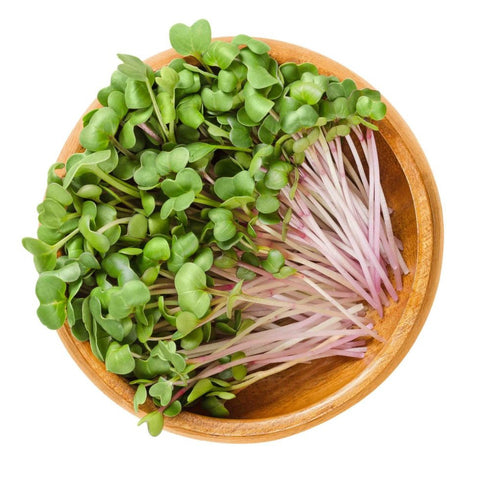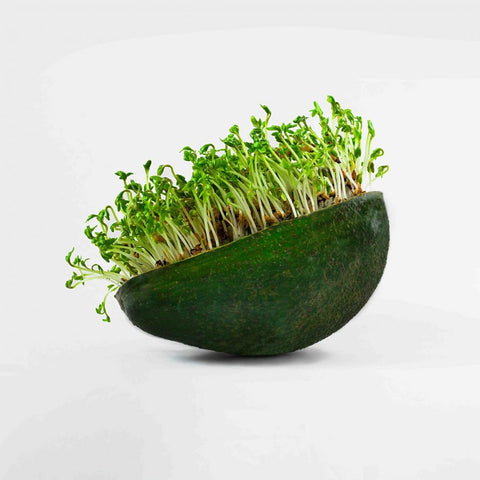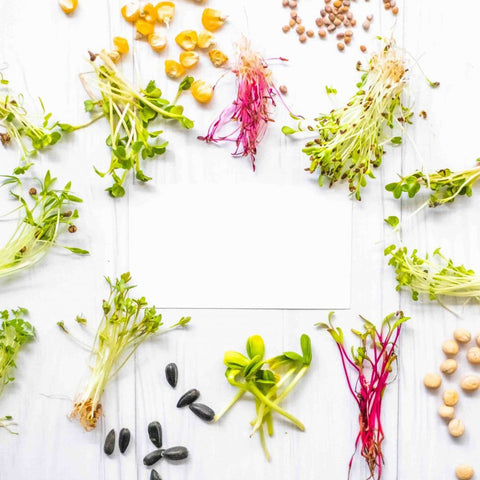With the busy lives we tend to live these days, making sure you’re eating well and getting your essential doses of vitamins and nutrients can often be tricky.
Many people turn to dietary supplements, but these can be both expensive and often have questionable ingredient lists. Microgreens offer a healthy and natural way to incorporate nutritious veggies into your diet, plus they’re fun to grow and perfect for beginner gardeners!
In this blog, we’ll discuss some of the primary health benefits of microgreens, and why these nutrient packed greens should be a staple of your healthy diet.
Why Are Microgreens Healthy?
A few qualities of homegrown microgreens come together to result in their designation as a ‘superfood’.
- First, microgreens are healthy because they are nutrient-dense – meaning they are concentrated sources of vitamins, minerals, and antioxidants. Compared to their adult counterparts, they contain up to 40x the vitamins (Source) and a broader spectrum of antioxidants (Source).
- Second, microgreens are suitable to eat raw which helps them retain their nutrients, as the high heat in cooking can destroy enzymes, vitamins, and phytonutrients (source).
- Finally, when homegrown, they’re fresh! As soon as any plant is harvested, it starts decomposing and losing its nutrients and health benefits. For example, spinach loses 90% of its Vitamin C within 24 hours of harvesting (source).
The only way to ensure you are capturing all the health and nutritional benefits of microgreens is to eat them as soon as they have been harvested. This is one of the main reasons why we recommend home-grown microgreens over store-bought ones. Fortunately, thanks to kits like these microgreens are easy to grow and suitable for people of all experience levels.
Microgreens Nutrition Facts: Microgreens are a good source of…
Each microgreen variety had its own ensemble of health benefits, but generally speaking, microgreens are a great way to get your vitamins, minerals, and antioxidants.
These are the raw materials that your body uses to perform hundreds of actions every day – from making your skin glow, to healing wounds and shoring up your bones.
You’ll also often read they are “high in fiber” and while this is technically true on a percent basis, fiber is really about total volume so you’re better off with big veggies if it's fiber you’re looking for..
- Vitamins: These are organic substances made by plants or animals. Microgreens tend to be rich in vitamin C, vitamin E, and carotenoids (which aren’t vitamins themselves but are used by our body to make vitamin A) (source).
- Minerals: These originally come from the earth and water & are then absorbed by plants and stored in their seeds and plant mass. The minerals microgreens tend to be the richest in are potassium, iron, zinc, magnesium, and copper (2, 3).
- Antioxidants: Antioxidants counteract unstable molecules that damage our body’s cells and DNA. One category of antioxidants, called polyphenols, is abundantly rich in brassica microgreens – like our Red Russian Kale – with samples containing 164 unique types (source). Another category of antioxidants, called carotenoids, was found to be about 5 times greater in microgreens than in adult leaves (source).
Microgreens Can Help Reduce Your Risk of Having these Deadly Diseases
As you may already know, vegetables are a good source of almost every essential vitamin and nutrient our body needs, making them very good for lessening the risk of having certain diseases.
As microgreens are also vegetables, they can also help reduce the risk of you having these deadly diseases:
- Alzheimer’s disease: Microgreens which are high in antioxidants, and also contain high amounts of polyphenols, may be linked to a lower risk of Alzheimer’s disease
- Heart disease: As discussed above, microgreens are a good source of polyphenols, which are a class of antioxidants that can help lower the risk of heart disease. Studies show that they can help by lowering triglyceride and “bad” LDL cholesterol levels
- Certain types of cancers: Microgreens are high in antioxidants, such as polyphenols, and these may be helpful in reducing the risk of various types of cancer.
- Diabetes: Microgreens have plenty of antioxidants that may help lower the type of stress that can prevent sugar from properly entering cells. In some lab studies, a specific variant of microgreens - fenugreek microgreens appeared to have enhanced cellular sugar uptake by 25–44%
What Are Microgreens’ Benefits For The Skin?
Various microgreens have health benefits for our skin, especially sunflower, radish, broccoli, kale, and nasturtium microgreens, as they provide essential skin nutrients: zinc, vitamins A, B, D, E, sulforaphane antioxidants like polyphenols. Microgreens also have anti-inflammatory effects which can be credited to the antioxidants existing within these tiny but mighty plants.
What Are Microgreens’ Benefits For The Hair?
Did you know that microgreens help damaged hair by reducing the chances of them breaking? Microgreens such as beetroot microgreens are particularly healthy for the hair as they are rich in iron, potassium, and electrolytes.
What Are The Most Nutritious Microgreens And What Are Its Benefits?
Pea Microgreens/Pea Shoots
Pea shoots contain beta-carotene – which our bodies convert into vitamin A, vitamin C, folate–essential building blocks for the human body, and fiber. These pea microgreens have a very mild taste, but they can add a crisp texture and green color to your salads and sandwich wraps.
Radish Microgreens/Sprouts
Radish microgreens can also be a nutrient packed option with loads of health benefits. . Radish microgreens include high levels of vitamins A, B, C, E, and K. They also deliver calcium, iron, magnesium, phosphorus, potassium, and zinc to the human body.
How To Grow Your Own Nutrient Packed Microgreens
Growing microgreens at home is both easy and incredibly rewarding and there exists many great kit options to help you get started! They’re suitable for people of all experience levels, and can be grown at any time of the year as long as you don’t let them get too cold.
If you’ve found this content useful and would like to learn more about how to grow your own food at home, then consider signing up for an email newsletter below.















I am a microgreen grower in the midwest… and would love to educate people at my farmers markets
Could you please send a price list of your microgreens
Thanks
Am really keen to try these
My body is screaming out for self care & eating better & more nutritional is where I want to start
Thanks for all the information! My friend gave me a starter kit but I have to get the trays and the lights. I just got results from (fasting) lab results and my bad cholesterol is high and my total cholesterol is high. I’m so excited to get my indoor little micro garden started to see what it will do for me. I have another lab in three months so I’m super excited to see if it helps, which I’ve heard it does.
Here’s expecting the best results. Looking forward to the benefits from eating my micro greens.
Want to learn more
I am definitely interested in this adventure
Awesome info.